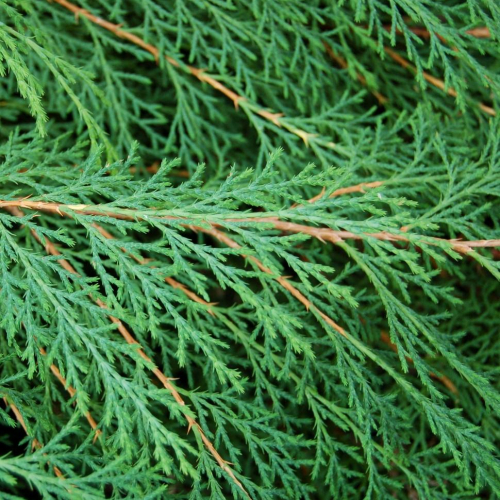Coniferous Microbiоta

Description
Characteristic Features of Microbiota
The genus Microbiota belongs to the cypress family Cupressaceae, pine order Pinales and contains a single species, Siberian Carpet Cypress or Russian Arbor-Vitae (microbiota decussata). It is a highly ornamental evergreen coniferous shrub native to the Russian Far East and listed in the Russian Red Book. In Russian, the plant is commonly referred to as the "stone pillow."
Microbiota can be found in the forests and forest edges, among the rocks, in the mountains and river valleys. Wild species occur in areas with fairly harsh conditions, frequent gusty winds and frosts down to -40 ° C, so the cultivated species can easily survive in adverse weather.
This plant was first described only in 1921; however, the botanist I.K.Shishkin took it for the juniper. In 1923, V.L.Komarov named this shrub Microbiota, as it looks very similar to Platycladus or Biota but has a more compact size.
Microbiota grows to about 100 centimetres in height and 200 centimetres in spread, has thin branching roots, a thin trunk (about 10-15 centimetres) and prostrate branches with scale-like dark green needles varying in shapes and sizes, arranged oppositely and crosswise. The branches are covered with smooth brown bark. In contrast to Biota, Microbiota's shoots are only slightly flattened.
In the winter, Microbiota's needles turn brown. They contain healing essential oils and you can smell a strong flavour when rubbing the branches in your hands. Due to this, the plant is used in medicine and cosmetology. The fruit is a small dry cone (about 5 millimetres long) with hard scales and black oval seeds, ripening in August and September.
Microbiotas make attractive ornamental plantings for rock gardens, stony hills, borders, group or solitary plantings, and are used as groundcover. It is an ideal shrub for rocky areas; besides, Miscrobiota stays attractive throughout the year. Perfect companion plants for Microbiota are the thuja, spruce, juniper, Japanese stone pine, and various mat-forming plants. Furthermore, this evergreen shrub, in particular its variety 'Compacta', is often grown in containers.
The Secrets to Successfully Growing Microbiota
Microbiota is very easy to keep. It is frost- and drought-resistant and does well in the shade and in full sun. Microbiota does not require special care as long as the soil is not waterlogged and contains a large amount of salts. For better growth, use a mix of humus, compost, peat, and sand. Prior to planting, place a layer of gravel or crushed stone about 20 centimetres thick into the planting hole.
The basic care involves watering after allowing the top soil to dry off (about 5 litres of water per plant) and misting in the evening (in the summer, it is best to mist daily). In addition, young plants require weeding and loosening the soil to about 6 centimetres deep. Prune only when necessary to shape the crown. It is best done in late April or in early May. In the autumn and spring, slightly mulch with peat. Very young seedlings need to be winter sheltered with spruce branches or dry leaves, so that spring frosts do not damage immature shoots. When the plant is 2-3 years old, feed it with compound fertilizer. After that, feed every two years.
Microbiota grows slowly (about 2 centimetres per year), so it is easier to grow a beautiful shrub from seedlings. Seedlings root well if they are provided with the conditions required for growth -- partial shade, good drainage, and fertile soil (humus loam is best).
Microbiota can be propagated by cuttings, layering, or seed. Cuttings are best cut in the summer. Rooting is fast enough even without using growth promoters. It is noteworthy that shoots that contact the soil frequently root themselves.
Since Microbiota is very wide-spreading, space the plants about one metre apart. Also note that only young plants can be transplanted; mature Microbiotas do not tolerate transplantation and are not like to continue growing well. Before transplanting, cut the roots of the plant.
If you propagate with seeds, first stratify them at 2 to 5 ° C and sow out in the spring. Freshly harvested seeds can be sown before winter without stratification with pre-soaking in Epin for 13-17 hours.
Potential Problems
In general, Microbiota is not prone to diseases or pests. However, in the wild, it often suffers from fires as its branches contain combustible resinous substances that immediately catch fire from the slightest spark.







 83 826
83 826







